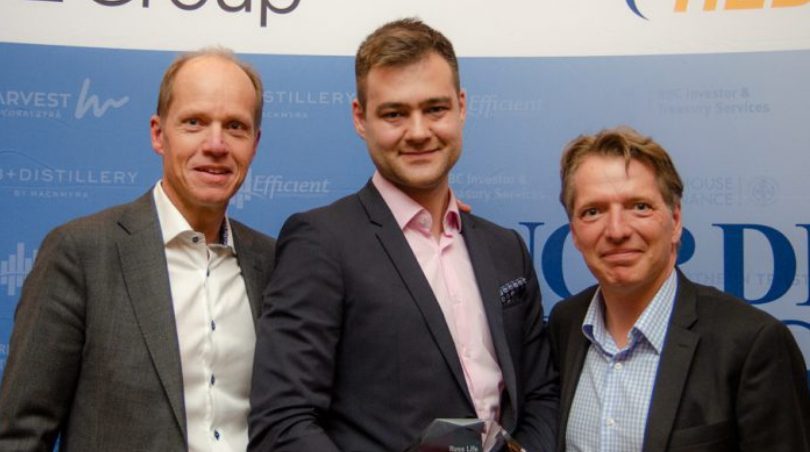One Replacement for Fixed Income
HedgeNordic | By EUGENIU GUZUN
Access original article here
Stockholm (HedgeNordic) – Fixed income has long been serving as an essential asset allocation component within most diversified portfolios. Amid historically low interest rates, buy-and-hold investors though are almost guaranteed to collect microscopic returns from this asset class over the years to come. A well-diversified portfolio of U.S. life insurance policies may provide investors with a better risk-reward alternative to fixed income, able to offer equity-like returns with volatility below that of investment-grade bonds.
“A well-diversified portfolio of life settlements that can achieve seven to eight percent net in U.S. dollars is a really attractive alternative fixed-income proposition,” believes Jonas Mårtenson, the founder of an alternative asset manager running a fund focused on U.S. life insurance policies. “We will likely never generate 20 percent in one single year and will probably not generate negative returns in a calendar year either,” continues Mårtenson. “For us, this is a long-term investment that acts as an alternative to buying private debt or other asset classes that have to go for lower credit ratings in order to achieve higher returns.”
“A well-diversified portfolio of life settlements that can achieve seven to eight percent net in U.S. dollars is a really attractive alternative fixed-income proposition.”
Ress Life Investments, Resscapital’s vehicle that was recognized as the Best Nordic Hedge Fund of 2019 by HedgeNordic, screens for unwanted life insurance policies from healthy and wealthy policy owners in their seventies with an average life expectancy of ten years. “The secondary market offers an alternative to policy owners to sell their policies at a higher cash value than the surrender value offered by the issuing insurance companies,” explains Mårtenson. After buying a life insurance policy in the U.S. secondary market for these policies, funds such as Ress Life Investments step in and continue to pay the due premiums until the death of the insured, resulting in the contract’s payoff.
“The secondary market offers an alternative to policy owners to sell their policies at a higher cash value than the surrender value offered by the issuing insurance companies.”
The purchase of a life insurance policy generates a return if the discounted value of the expected future benefits of the policy exceeds the present value of all expected premium payments to be made and the cost of acquiring the policy. “The key risk we take, of course, is the longevity risk,” emphasizes Mårtenson. “The fact that people are living longer in the Western world is a well-known fact, we know that, everyone knows that,” he continues. To mitigate the longevity risk, the investment team at Ress Life Investments led by Anton Pozine predominantly seek to buy policies from people with longer life expectancies.
“We buy policies from people who are very healthy, because we think that long life expectancies are more accurate,” points out Mårtenson. “The only thing we care about is having accurate life expectancies.” Ress Life Investments also seeks to mitigate the impact of longevity risk by buying single policies. “We are cherry picking, only having bought approximately 400 policies since inception having reviewed over 10,000 policies,” says Mårtenson. “We are buying very selectively, trying to buy policies where we feel the risk is lower for our investors and by lower risk, we mean lower sensitivity to an increase in life expectancies.”
“We are cherry picking, only having bought approximately 400 policies since inception having reviewed over 10,000 policies.”
Because longevity – the main risk factor in a portfolio of life insurance policies – is mostly uncorrelated to economic cycles and traditional asset classes, Ress Life Investments not only acts as an alternative to fixed income but also as a true diversifier within a portfolio. “This is a very interesting asset class that offers completely uncorrelated returns, which is difficult to find for investors in these days,” says Mårtenson. “The low volatility and predictable cash flows of a well-diversified life insurance portfolio offer a highly attractive, asymmetric risk profile, well-suited to fixed-income investors prioritizing capital preservation.”
“This is a very interesting asset class that offers completely uncorrelated returns, which is difficult to find for investors in these days.”
An Example of Socially Responsible Investing
There are rational economic reasons for policyholders to sell their life insurance policies. “Our life settlements transactions start with policy owners who no longer want or need their policies,” says Cristina Lugaro of Resscapital. Some policy owners see no need for their life insurance policies and decide to stop paying the premiums. “This is actually the most common alternative, people just stop paying the premiums and the policies lapse within 60 days,” says Mårtenson. “Nine out of ten policies in the U.S. will lapse without paying out. For life insurance companies, this is a very profitable product since most policies never pay out.”
It is financially beneficial to policy owners to sell their policies to a third party rather than surrender them to life insurance companies. “We really think that buying life settlements is a sustainable investment, which provides value to both the sellers and also the buyers in this case,” argues Lugaro. “Policy owners are getting value by having the opportunity to sell policies on the secondary market.”
“We really think that buying life settlements is a sustainable investment, which provides value to both the sellers and also the buyers in this case. Policy owners are getting value by having the opportunity to sell policies on the secondary market.”
Without a secondary market for life settlements, policy owners could either let their policies lapse and get nothing, or get a symbolic surrender value from insurance companies. “The strategy of buying unwanted life insurance policies is very positive and sustainable because it is adding value to consumers,” says Lugaro. “The secondary market is also disrupting a market where the insurance companies have the absolute pricing power over the policies,” she continues. “Owning a policy is like owning financial assets such as equities, bonds, or real estate,” adds Lugaro. “You have the right to sell it if you don’t need this protection anymore, and maybe put the money into something you need now, in other things like long-term healthcare, for example.”
Is Covid-19 Making Policies More Profitable?
One ethical consideration raised by investors includes the impact of the coronavirus pandemic on policy owners and the possible premature payouts from the most unfortunate victims of the pandemic. “One would think that the coronavirus will increase the mortality rates and trigger faster payouts, which would be unethical because it is taking advantage of these people who are dying,” says Lugaro. “But that is not the case in our portfolio,” she claims. “We tend to acquire policies from quite healthy and wealthy individuals who have access to healthcare, who are quite well-informed and likely to embrace social distancing measures,” says Lugaro. “We have not seen a major impact of the COVID-19 pandemic on our portfolio.”
High Barriers to Entry
Life settlements investing may sound simple and lucrative for investors, but this approach to investing is not quite that simple. According to Mårtenson, the secondary market for life insurance policies is associated with high barriers to entry. “The secondary market is very much an OTC market where you are relying on finding good policies through brokers,” says Mårtenson. “If you are an unknown market participant, you don’t know the brokers and you don’t know which brokers have access to attractive policies, you may find yourself in a rather difficult position.”
“If you are an unknown market participant, you don’t know the brokers and you don’t know which brokers have access to attractive policies, you may find yourself in a rather difficult position.”
A new portfolio of single life insurance policies is also associated with a so-called J-curve effect, which describes the initial loss-making period that precedes the first policies paying out. “You own zero policies when launching, so your portfolio is not very diversified at the beginning,” says Mårtenson. “You do not expect any policies to pay off in the early years, so there is a J-curve effect as it takes time to build a diversified portfolio,” he continues.
“You do not expect any policies to pay off in the early years, so there is a J-curve effect as it takes time to build a diversified portfolio.”
“The fund was started in 2011 and only had $10 million in assets under management,” says Lugaro. “It took some time for the first policies to pay out and building that portfolio, which currently oversees $223 million, contains 335 policies and is well-diversified by different parameters.” Other barriers to entry, less visible to the naked eye, include the expertise and experience required to operate in this secondary market for life settlements. “It is a lot of admin work and a lot of knowledge required to operate,” points out Mårtenson. “The market is associated with high barriers of entry, and not easy for newcomers to join.”
“The market is associated with high barriers of entry, and not easy for newcomers to join.”
“This secondary market is still quite a small niche,” says Mårtenson, enabling Ress Life Investments to defend against larger players with significantly higher amounts of dry powder. “The annual volume is approximately $5 billion and it is growing steadily,” he continues. “More participants, more buyers, and lots of new funds are being set up. But since the market is still quite niche, it is very difficult for large players to buy single policies.”
About Resscapital
Resscapital AB is an alternative investment fund manager (AIFM) authorised and regulated by the Swedish Financial Services Authority (Finansinspektionen).
We have since 2011 bought a diversified life insurance portfolio on behalf of Ress Life Investments, which is listed at NASDAQ Copenhagen. Proprietary portfolio management systems and pricing models have been developed. The company also collaborates with independent medical underwriters specialising in senior mortality.
The management team has complimentary backgrounds and international experience from having worked at major banks, institutional investors and hedge funds. The board of directors consists of both successful entrepreneurs and senior managers with extensive experience from the financial industry.
See here for more news from Resscapital AB
Attractive Long-Term Returns
Ress Life Investments A/S purchases US life insurance policies in the secondary market. The company owns a diversified portfolio and policies are issued by over 50 highly rated US life insurance companies. The investment objective is to provide attractive uncorrelated returns in USD over the long-term. Ress Life Investments is listed at Nasdaq Copenhagen since 2015.
Attractive risk-adjusted return – the target return is 7% per annum in USD without any leverage.
Low volatility – a well-diversified life insurance portfolio offers investors stable and attractive risk-adjusted returns. Monthly historical volatility during the last five years is 4%.
Risk diversification – the return profile of the life insurance portfolio is characterised by low correlation to other asset classes, which makes the strategy attractive for investors seeking risk diversification.
Exchange-traded – the company is listed at NASDAQ Nordic and a market-maker provides daily prices.
Ress Life Investments A/S is a limited liability company incorporated in Denmark. The company is an alternative investment fund (AIF) managed by Resscapital AB, a limited liability company incorporated in Sweden. Resscapital AB is authorised as an alternative investment fund manager (AIFM) and supervised by Finansinspektionen, the Swedish Financial Supervisory Authority.
The depositary for Ress Life Investments A/S is Artha Fondsmaeglerselskab A/S. The administrator is Citco Denmark ApS, which is part of the Citco Group. The independent board consists of four members with extensive experience from the financial markets. Ress Life Investments A/S is audited annually by Deloitte.
Ress Life Investments A/S is admitted to trading and official listing on NASDAQ Copenhagen. The company’s short name is RLAINV, ISIN DK0060315604. Current share prices can be found under the segment – Alternative Investment Funds on NasdaqOMXNordic.
Danish and Swedish retail investors and professional/accredited investors may also subscribe for shares on a monthly basis at the company’s current net asset value per share.




